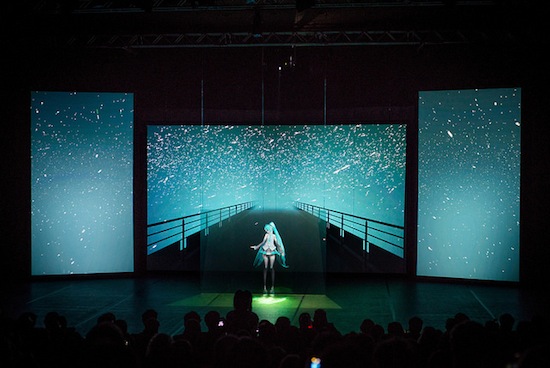Haus Der Kulturen Der Welt is an art gallery and performance space that stands on the banks of the Spree near the Reichstag in Central Berlin. Paid for by the Benjamin Franklin Foundation and designed by the architect Hugh Stubbins, the foundations for the HKW were laid in on October 3rd 1956. It was described as "America’s gift to the world" or, as its curving roof rose over the Tiergarten, by Berliners as "Die schwangere Auster’" – "the pregnant Oyster’. Inside the main entrance is a plaque commemorating the gift in the spirit of solidarity. Or, as some critiqued it, a physical manifestation of American cultural imperialism in the ideological battle against Communism, the soft power reinforcement to the tanks stationed near the wall in West Berlin. In 1980, part of the roof caved in, killing one and injuring many. Someone tells me that this event inspired Einsturzende Neubauten (their name ‘collapsing new buildings was itself a satire on West Berlin’s shoddy post war architecture) to call their debut album Kollaps.
The international exchange of art and ideas has long been complicated and frequently awkward, both reinforcing and critiquing existing international power structures. In the past, this was traditionally in one direction: the first world dumping its pop music and art venues as leverage across poorer nations and in return exoticising the global under the patronising catch all of ‘world music’. In 2016, however, we live in turbulent times. This edition of CTM comes under the theme "New Geographies", and it couldn’t feel more timely. On my first weekend in Berlin I visit the German technical museum, situated in the remains of the Anhalter Bahnhof, much of which has remained in ruins since the end of World War Two. Here in an old engine shed, a row of sleek and powerful railway engines charting the early years of the German railway suddenly ends and there’s a simple wooden wagon, planking chipped and worn inside, and empty aside from a photograph of an old lady wearing a star of David. Walking down Tempelhofer Ufer afterwards, I look into the bright lights of what might have been a school and see row upon row of beds covered in white sheets. Outside the refugee shelter, men stand around smoking. Later in the week I speak to a German who tells me his Turkish friend is now afraid to to cycle outside of the Berlin city limits into Brandenburg for fear of being beaten up. A Czech woman here for Transmediale will email me after the festival saying that as she arrives back in Prague there are far right attacks on refugees and independent press outlets. Many of her friends have had their photographs and contact details put online by an extreme "multiculti watch" organisation. While I’m away, back in England, disturbances against our own far right end up with a swastika daubed in blood on the side of a coach carrying antifa protesters.
Just as was the case when I reviewed CTM’s Siberia edition last year, this political context is impossible to ignore as the festival progresses over an superbly put-together ten days of performances, club nights, and talks. Where sometimes electronic music festivals can feel rather like a hip musical Starbucks as they export their Boomkat-ready ‘sick’ line-ups around the world, what’s so striking about CTM’s focus on the Berlin event (for which the Siberian one-off was a feeder) is just what a glorious union of non-‘western’ sounds this is. Indeed, the only British and UK-based artist I see in over a week is Mumdance, who closes my CTM with an absolute brain-melter of a set that rushes across grime, techno, that superlative Total Freedom remix of Rhianna and jungle, and features a yelping, snarling set from Kevin Martin associate Miss Red. On the Thursday night, across eleven hours of music, I realise I’ve not seen a single white male performer on any of the CTM stages, from the HAU art space to Berghain.
The mood for all this is set on the opening night with Rabih Beaini’s performance at HAU.
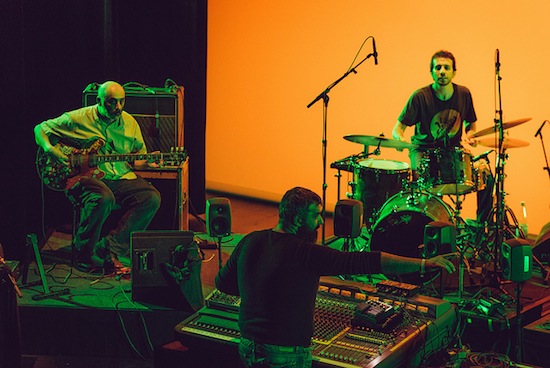
Indeed, he’s been a driving force and co-curator of this year’s CTM, and the entire festival has the feel of one of his DJ sets, broad-minded, cross-continental, fun and strange. Tonight, he’s set up in the centre of the stage, back to the audience, in front of a mixing desk and flanked by two rows of musicians from across the world, all with the same instruments trumpet (Liz Allbee, Mazen Kerbaj), guitar (Sam Shalabi, Sharif Sehnaoui), drums (Daniele De Santis, Tommaso Cappellato), and voice (Sofia Jernberg, Rully Shabara) but interpreting them in entirely different ways, Beaini manipulating the sound in and out of cacophony, modulating noise versus groove. It’s perhaps more affecting that you might expect and sets up one of the recurring sentiments of CTM 2016: that of a Tower Of Babel, where a tumult in sound, languages and aesthetics feels like a celebration of the possibilities of unselfconscious and open collaboration.
With this in mind, the general feeling I get throughout CTM is that the festival is offering a neutral platform on which a genuine change in the global power structures of the music industry, and musical art, are being explored. It acts as an interesting parallel to Berlin as a city where the world’s hackers increasingly feel safe to congregate thanks to the echoes of history making its population skeptical about state surveillance. Make no mistake about it, this is all about the decline of the ‘west’ (defined as the USA and Europe including the UK) versus the ‘developing’ or ‘third’ world, where new models, musical forms, and distribution models are making our music business look like an antiquated relic and post-war blip. As musical explorer, sound recordist and archivist Christopher Kirklay says in a panel discussion that when he’s recording music across the world children appear around him with their phones out, also taping. He, as an American ethnologist will no longer be needed, as the rest of the world is recording itself.
But what does this new world sound like? A common agreement, across panels and in discussions and in the way everything sounds here at CTM, seems to be that fragmentation is now global in a connected underground. Why should a scene in Cairo or Mexico City not be as important as anything in Berlin, London, or New York? They function in similar ways, after all. As Sublime Frequencies founder Richard Bishop says about what’s happening in Cairo "we’re all in it together, everyone knows everyone". It is also, he remarks, a hugely significant regional city: for "Egypt is the energy of the Arab unconscious".
He plays in the Cairo-based Dwarfs Of East Agouza with Sam Shalabi (also known in the wonderful Land Of Kush) and Maurice Louca (who wrote Quietus-favourite ‘Salute The Parrot’). There’s saxophone and a rumbling, a jam session half heard flowing down a cave with sluggish and saturated sand, then drums start rattling underneath and the guitar twang and dissolves, and Louca fingers out a keyboard pattern while twiddling a wheel to warp the notes, high energy psychedelia at its undefinable best. In the panel discussion Maurice Louca says that he’s not concerned about identity in music "in any way", remarking that his music is contextualised after the fact, from the outside.
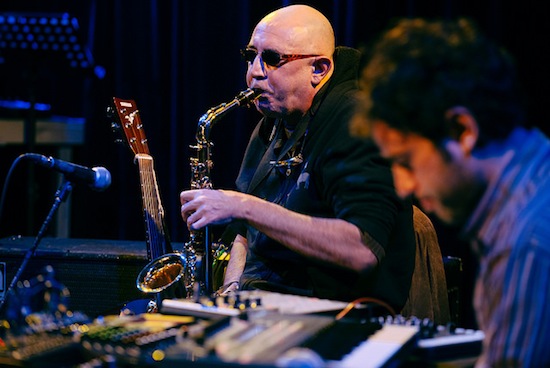
This outside interference of western opinions comes up a few times over the course of CTM. In a Q&A the morning of their club set, Paul Marmota and Alejandro Núñez of NAAFI express a frustration with the exoticisation of Mexican and Latin artists, especially in the USA. They’re also critical of social media and its use for a constant stream of accusations of cultural appropriation directed their way from outside. As they point out, Mexico is a uniquely mixed country, the sum of hundreds of years of invasion, migration, slavery, exploitation, sharing, and dialogue. Authenticity exists nowhere, and history is by its nature problematic across the globe. For example, Sudanese artist Sarah Abunama-Elgadi of Alsarah & The Nubatones makes music based on traditional wedding songs but is deliberately unauthentic. She also brings unacknowleged histories of inter-African slave trades into her work.
I hardly need to say that the internet, and especially social media, are central to this new global paradigm. As Abunama-Elgadi says, "The internet is interesting for the diaspora to exoticise its own self – Africa and Asia can consume and exoticise themselves". She explains that WhatsApp is huge in Sudan, and on it groups of hundreds or thousands of users share videos and music that then go viral. This is then exploited by the artists, who are able to generate revenues by partnering with brands. In Ghana, pop rap group FOKN Boys are pranskers who seem incredibly adept at turning these new systems into cold hard cash. They make music as self therapy, using humour and mockery as a way of staying sane against anyone from the church, to the mobile phone providers that give them their exposure, and the state. In Ghana, a popular song loved by the government is called ‘We Don’t Care What You Think’, and the president likes to dance to it – even Donald Trump might be wary of appearing so gauche. There’s a film about them shown at the end of CTM that has FOKN Boys in a Ghanaian market, rattling a yellow bucket with ‘help America’ written on it and a sad face "Somalia help America… Give them something to eat". A voiceover explains that it will take years to raise the money but they feel they must start now for "we are on the way up, but unfortunately America is on the way down". We in the West are complacent in its technological ‘superiority’, and our artists’ resistance to streaming media or piracy is, in relation to much that I observe at CTM, Cnut-like compared to elsewhere. In countries where there the electricity supply is unreliable, music is transferred on SIM cards. Across Africa, mobile phone repair shops are the new music stores, where phones have their libraries copied, with songs then sold on burned CDs by customers who come in and pay by the megabyte.
Music and commerce appears to be an incredible state of flux across the globe, even more so than in the UK. What’s striking is that most of the artists who speak over the course of the week are remarkably sanguine when it comes to ideas of copyright, ownership, or value. Much has changed in Russia since I was there back in September. The collapse of the rouble due to falling energy prices and sanctions imposed after Putin’s invasion of the Ukraine means that earnings have plummeted, with even doctors earning less than €200 a month. Ivan Afanasyev of Love Cult and Stanislav Sharifullin AKA HMOT tell me about Russian Facebook-equivalent VKontakt, where all the world’s music and film is available, pirated and for free. After a string of buyouts and closures, the music press in Russia is effectively over, so writers and artists use the Telegram app (popular with ISIS due to its security) to create channels through which to share words and songs. But music in Russia has always been difficult to share. The Communists buried or appropriated folk traditions, writing endless dirges romanticising soldiers of the Great Patriotic War. Sharifullin’s father was an illegal DJ in the 1970s, using smuggled reel-to-reel tapes of German groups like Can and Kraftwerk at parties just outside Novosibirsk. At CTM, Love Cult and Buttechno represent the lives of modern Russian youth as they play sets in front footage of giant Russian housing complexes, superficially anonymous but with narrative vignettes played out in front of them, a girl pirouetting across railway tracks.
Actual, physical spaces have a large part to play across CTM – these New Geographies are not virtual ones, by any means. In contrast to the intimacy of headphones or near-fuzz of mobile phone speakers, there’s discussion over music played in public space as sound art. Georg Klein discusses how sound artists are looking for "a space of tension", conflict in communities or places with difficult architecture. Nicola Mullerschon talks about a Nigerian and Indonesian collaboration, street art drawing alongside percussive and melodious music. Victor Ehikhamenor, visual artist, creates the JOLA gethuk sound system by using a hand-pushed food trolley commonly found on the streets of Indonesia the platform to play Nigerian music on the streets of Jogja. There’s a quote from Fela Kuti painted on the side: "I will be master of my own destiny". Anna Raimonde and Alya Sebti, who first worked together at the Mareakesh biennale, express an optimistic view that sound art in many of the world’s public spaces is able to be more autonomous from commerce and marketing than more consumer-focussed art. Or, it can perhaps play with it on a micro level. In Marakesh they placed an installation in public taxis, which they describe as already being "a sonic device" with drivers acting as mediators, recommending pieces to their passengers.
The political and physical spaces, and the potential of their exploration in sound, is also discussed by a sound piece by Israeli artist Meira Ashera, whose work explores the militarisation of her country’s schoolchildren. In an interview via Skype afterwards, she insists that her sound art isn’t abstract, saying that "sound waves are just part of the work" involved in activism, for example spreading the stories of refuseniks who won’t do their conscription into the Israeli military. She adds that sound art also has a political dimension in the sonic documentation, day by day and hour by hour of the Israeli assaults.
A playful strangeness unites so many of these performances and sets in a way that actually feels rather utopian. Rather than the self-conscious, gaudy tackiness of much pan-global internet era art and music that we’re used to from the West, much of what’s on offer at CTM picks up routes from the physical, the traditional, the political and subconscious. Even many of the ‘western’ artists seem to be making sounds from parts of the creative imagination that we’re little used to hearing explored.
This is a new world united in trance – Keiji Haino and Senyawa builds from abstract improvisations to manglings of Rully Shabara’s guttural vocalisations, I feel like I’m gradually sliding through the colon of a mammoth out for a post-prandial jog… Shabara is a wonderful presence, forehead wrapped in cloth, gesticulating, wandering the stage and having a screaming duel with Haino, who puts on sunglasses and starts waving around what looks like a giant slinky, a whine like a baby pining for the teat.
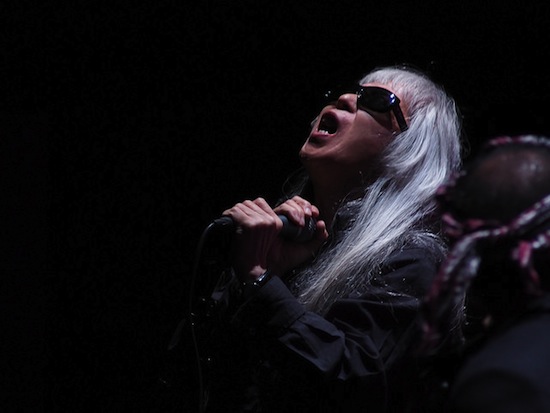
Some of these folk creatures that seem to move beyond recognisable forms, too. Take the Breadwoman and her sad face, pig eyes dimples and giant potato of a nose, sat on a chair gradually sliding down in her hessian cloak, the loaf she’d been cradling slipping out of her arms. It’s like some character from a Brothers Quay come to live, the tool of Anna Holmer & Steven Warwick as they unleash gargling vocal sounds male and female, electronic growls and pipes croaking froglike from the back of the stage. Most vivid of all is Aisha Devi’s set at the Berghain on Thursday night. Indeed, it’s so vivid that it actually pass out at one point when Tianzhuo Chen’s visuals of a tattooed and pierced small person on the huge screen at the back of the stage appears to start talking to me. Devi plays alongside a piece by Chinese dancer and choreographer Beio. Adorned with bling and a dyed beard, he gyrates next to another dancer in grotesque and staring mask as he theatrically twirls an umbrella.
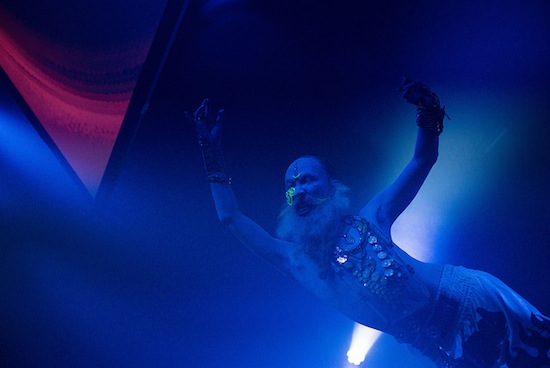
There’s a whole week of this: Stephen O’Malley, who couples a henge of amps with the Berghain PA for one of the loudest and oddly joyous sets I’ve ever encountered; Romania’s Iancu Dumitrescu half conducting, half wrestling spellbinding discord from the strings, percussion and brass of the Hyperion Ensemble; erotically-charged Throbbing Gristle-indebted techno by Group A; Sharif Sehnaoui’s luminous yet punishing guitar playing as Omar Rajeh and Malek Andary perform a graceful yet masculine Lebanese sword dance in front of him; the brilliantly curated videos, sculptural pieces at the ongoing Seismographic Sounds. Visions of a New World exhibition; Tien-Lai’s Gnod-like affirmation of the brilliance of contemporary Polish experimental music; the controlled chaos of the Hyperion Ensemble. These are unusual hallucinations, fragments caught from the corner of the minds eye but interlinked and underpinned by serious intent.
Part of this year’s co-curation between CTM and Transmediale, the contemporary art festival that runs alongside it, is the final performance in the main auditorium at HKW. Actually, it’s not a performance at all, but somewhere between the presentation of a product, AV playback and a documentary. Hatsune Miku, with long teal hair and impossibly skinny frame, appears onstage as a hologram. She’s a character invented to market Yamaha’s vocal synthesiser plug-in, and has become a ‘star’ in her own right, with artists across the world using her voice in compositions from J-Pop to soul and metal. It’s a warping of the boundaries between technology, artist, identity and commerce – one of the voiceovers on the film says, "production and consumption can be simultaneously realised for the first time". The music is, to be honest, pretty dire, shlocky, cliché-ridden ("if this is love I want to wear it on my sleeve") J-Pop schmaltz. This is "character product", a voice says, making a comparison with sex workers as Miku flicks her hair on the stage. Two Italian women next to me shout "this is bullshit", and cause a hubub as the row has to rise to let them out. Words ring out underneath the roof of the HKW: "Alone is fun, together is fun – a new experience through interactivity" and suddenly, the glowing plastic that holds the hologram feels like a cell. Afterwards, hundreds crowd the stage for a selfie with this celebrity slave. I have the unusual, unfamiliar sensation of feeling sorry for a hologram.

